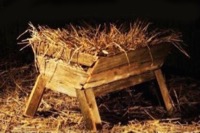Difference between revisions of "Manger"
From Nordan Symposia
Jump to navigationJump to searchm (Text replacement - "http://nordan.daynal.org" to "https://nordan.daynal.org") |
|||
| Line 2: | Line 2: | ||
==Origin== | ==Origin== | ||
| − | [ | + | [https://nordan.daynal.org/wiki/index.php?title=English#ca._1100-1500_.09THE_MIDDLE_ENGLISH_PERIOD Middle English] from Old French ''mangeure'', based on [[Latin]] ''manducat''- ‘chewed’ |
*[http://en.wikipedia.org/wiki/14th_century 14th Century] | *[http://en.wikipedia.org/wiki/14th_century 14th Century] | ||
==Definition== | ==Definition== | ||
Revision as of 22:30, 12 December 2020
Origin
Middle English from Old French mangeure, based on Latin manducat- ‘chewed’
Definition
- 1: a long open box or trough for horses or cattle to eat from.
Description
A manger, or trough, is a feeder that is made of carved stone, wood, or metal construction and is used to hold food for animals (as in a stable). Mangers are mostly used in livestock raising. They are also used to feed wild animals, e.g., in nature reserves. A manger is also a Christian symbol, associated with nativity scenes where Mary, forced by necessity to stay in a stable instead of an inn, used a manger as a makeshift bed for the baby Jesus.
